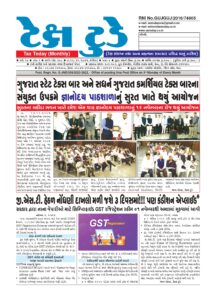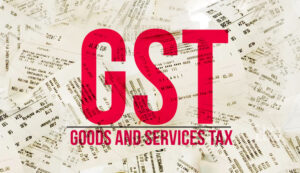GST WEEKLY UPDATE :27/2024-25 (06.10.2024) By Vipul Khandhar

-By Vipul Khandhar
- Advisory for Biometric-Based Aadhaar Authentication and Document Verification for GST Registration Applicants of Kerala, Nagaland and Telangana:
This is to inform taxpayers about recent developments concerning the application process for GST registration. It is advised to keep the following key points in mind during the registration process.
- Rule 8 of the CGST Rules, 2017 has been amended to provide that an applicant can be identified on the common portal, based on data analysis and risk parameters for Biometric-based Aadhaar Authentication and taking a photograph of the applicant along with the verification of the original copy of the documents uploaded with the application.
- The above-said functionality has been developed by GSTN. It has been rolled out in Kerala, Nagaland and Telangana on 5th October 2024.
- The said functionality also provides for the document verification and appointment booking process. After the submission of the application in Form GST REG-01, the applicant will receive either of the following links in the e-mail,
(a) A Link for OTP-based Aadhaar Authentication OR
(b) A link for booking an appointment with a message to visit a GST Suvidha Kendra (GSK) along with the details of the GSK and jurisdiction, for Biometric-based Aadhaar Authentication and document verification (the intimation e-mail)
- If the applicant receives the link for OTP-based Aadhaar Authentication as mentioned in point 3(a), she/he can proceed with the application as per the existing process.
- However, if the applicant receives the link as mentioned in point 3(b), she/he will be required to book the appointment to visit the designated GSK, using the link provided in the e-mail.
- The feature of booking an appointment to visit a designated GSK is now available for the applicants of Kerala, Nagaland and Telangana.
- After booking the appointment, the applicant gets the confirmation of appointment through e-mail (the appointment confirmation e-mail), she/he will be able to visit the designated GSK as per the chosen schedule.
- At the time of the visit of GSK, the applicant is required to carry the following details/documents
(a) a copy (hard/soft) of the appointment confirmation e-mail
(b) the details of jurisdiction as mentioned in the intimation e-mail
(c) Aadhaar Card and PAN Card (Original Copies)
(d) the original documents that were uploaded with the application, as communicated by the intimation e-mail.
- The biometric authentication and document verification will be done at the GSK, for all the required individuals as per the GST application Form REG-01.
- The applicant is required to choose an appointment for the biometric verification during the maximum permissible period for the application as indicated in the intimation e-mail. In such cases, ARNs will be generated once the Biometric-based Aadhaar Authentication process and document verification are completed.
- The operation days and hours of GSKs will be as per the guidelines provided by the administration in your respective State.
- Advisory on Proper Entry of RR No./Parcel Way Bill (PWB) Numbers in EWB system Post EWB-PMS Integration:
Subject: Guidance for Accurate Entry of RR No./Parcel Way Bill (PWB) Numbers following the Integration of E-Way Bill (EWB) with Parcel Management System (PMS)
It is to inform that the Parcel Management System (PMS) of Indian Railways has now been integrated with the E-Way Bill (EWB) system via Application Programming Interfaces (APIs). This integration facilitates the seamless transfer of RR No./Parcel Way Bill (PWB) data from Railways to e-way bill portal , ensuring better traceability and compliance.
In light of this, it is important that taxpayers follow the correct process for entering Parcel Way Bill numbers into the EWB system. Adherence to the guidelines below will help avoid any potential discrepancies or mismatches.
- Applicability of RR No./PWB Entry in the EWB System
Taxpayers transporting goods via the Indian Railways Parcel Management System (PMS) must ensure the correct Parcel Way Bill (PWB) number or RR No. is furnished in the e-way bill Part-B on EWB Portal. The format for entering RR No./PWB numbers has been standardized to ensure consistency and accuracy.
- Updating Part-B of EWB for Rail Transportation
- a) Suppliers with a pre-existing E-Way Bill (EWB) for goods transported from the factory to the railway station, and who are subsequently transporting goods by rail under the Parcel Management System (PMS), must follow these steps:
- Update Part-Bof the E-Way Bill using the “Multi-Transport Mode” option on the EWB portal.
- In the updated section, select Railas the mode of transport.
After selecting this option, the system will prompt you to enter the corresponding RR No./Parcel Way Bill (PWB) number.
- Format for Entering the RR No./PWB Number
The Parcel Way Bill number must be entered in the following format:
- a) PXXXRRNo, where:
- P stands for the Parcel Management System (PMS).
- XXX refers to the From Station Code of the originating railway station.
iii.RRNo is the actual Railway Receipt number issued for the goods.
Example:
If the Railway Receipt number in the PMS system is 2020-307306, it should be entered as PNZM2020-307306 where P stands for PMS , NZM stands for the originating station code and then the RR No. in the EWB system to avoid any validation errors.
4.RR Number for FOIS or Leased Wagons
For goods transported via the Freight Operations Information System (FOIS) or Leased Wagons, the process for entering the RR number remains the same as in previous advisories. The Railway Receipt number must be entered in the EWB system exactly as shown in the RR receipt, without any changes or formatting alterations.
- EWB and RR No./PWB Number Validation
After entering the RR No./PWB number into the EWB system:
- a) The EWB system will validate the RR No./PWB number against the data received from the Parcel Management System (PMS) of Railways.
- b) If a mismatch is detected or the RR No./PWB number is not found in the database, an alert will be generated. Therefore, it is advised that taxpayers ensure the correct entry of RR No./PWB numbers to avoid future discrepancies.
- Importance of Accurate Entry
It is crucial for taxpayers to ensure that the Parcel Way Bill number is entered correctly in the EWB system to allow smooth tracking and verification of goods being transported via Indian Railways. Accurate entry will also facilitate the validation process and avoid unnecessary delays or complications.
- Assistance and Clarifications
For further assistance or if there are any discrepancies in entering RR No./PWB numbers, taxpayers are encouraged to raise a ticket with the support team, clearly mentioning the RR No./PWB number.
- Advisory: GSTN e-Services App to Replace e-Invoice QR Code Verifier App Shortly:
GSTN is pleased to inform the launch of the new GSTN e-Services app, which replaces the old e-Invoice QR Code Verifier App. This app offers the following features:
Verify e-Invoices: Scan the QR code to verify the B2B e-Invoices QR code and check the live status of the Invoice Reference Number (IRN).
GSTIN Search: Search for GSTIN details using the GSTIN or PAN.
Return Filing History: View the return filing history for a GSTIN.
Multiple Input Methods: Input search details using text, voice, or scan functions.
Result Sharing: Share search results via the app.
The app would soon be available on the Google Play Store and App Store. No login is required to use the app.
MAJOR CHANGES IN AVAILMENT OF ITC BACK DATED
Effective September 27, 2024, via Notification No. 17/2024 – CT, two key changes have been made to Section 16 of the CGST Act:
- Section 16(5): Allows taxpayers to claim ITC for invoices/debit notes from FY 2017-18 to FY 2020-21 in returns filed till November 30, 2021*, overriding earlier deadlines.
- Section 16(6): Taxpayers with cancelled but later reinstated registrations is now allowed to claim ITC for transactions during the cancellation period, up to November 30 of the next financial year or the revocation date, whichever is later.
Also Sec 150 is effective from 27 Sep 24 wherein tax paid or ITC reversed prior to above sec being applicable shall not be refunded.
- AAR & Important judgements:
(i) (SC) SUPREME COURT OF INDIA Chief Commissioner of Central Goods and Service Tax v. Safari Retreats (P.) Ltd.
GST : Clauses (c) and (d) of section 17(5) are constitutionally valid; plain interpretation of said clauses does not lead to any ambiguity and, hence, question of reading down these provisions does not arise; question as to whether construction of immovable property carried out by an assessee amounts to plant is to be decided on its merit by applying functionality test.
Input tax credit – Apportionment of credit and blocked credit – Constitutional validity of clauses (c) and (d) of section 17 – Reading down – Right of ITC is a creation of a statute, Legislature can always carve out exceptions to entitlement of ITC – No one can claim ITC as a matter of right unless it is expressly provided in statute – Immovable property and immovable goods for purpose of GST constitute a class by themselves – Clauses (c) and (d) of section 17(5) apply only to this class of cases – Clauses (c) and (d) of section 17(5) are constitutionally valid – Plain interpretation of these clauses does not lead to any ambiguity; hence, question of reading down these provisions does not arise – Question whether a mall, warehouse or any building other than a hotel or a cinema theatre can be classified as a plant within meaning of expression ‘plant or machinery’ used in section 17(5)(d) is a factual question which has to be determined keeping in mind business of registered person and role that building plays in said business – If construction of a building was essential for carrying out activity of supplying services, building could be held to be a plant and then, it is taken out of exception carved out by clause (d) of section 17(5) to sub-section (1) of section 16 – To decide whether a building is a ‘plant’ for purposes of clause (d) of section 17(5) functionality test will have to be applied in each case, on facts [Section 17 of Central Goods and Services Tax Act, 2017] [Paras 64, 65 and 67] [Partly in favour of assessee]
(ii) Words and Phrases: Expression ‘Plant and machinery’ as occuring in section 17(5)(d) of Central Goods and Services Tax Act, 2017.
HC quashes Notification 56/2023 extending time limit to pass order under GST([1] TS-588-HC(GAUH)-2024-GST)
A recent ruling of the Gauhati High Court (HC)[1] on the validity of notifications extending the time limit to pass order under section 73(10) of Central Goods and Services Tax Act, 2017 (CGST Act).
The key observations of the HC are:
- Since the orders under dispute were passed basis the extension provided by Notification no. 56/2023 (the Notification), the Court is not considering challenge to Notification No. 9/2023 (earlier extension notification).
- There is no denial to the fact that the Notification was issued without the recommendation of the GST Council.
- In the Notification, the Central Government for reasons best known, mentioned “on the recommendations of the Council”, which on the face of it shows that the exercise of power by the Government insofar as the Notification is concerned, is a colourable exercise of power.
- Since the Notification was issued without the recommendation, GST Council had no occasion to consider existence of force majeure.
- Recommendations to be made by the GST Council if required as per the provisions of the Central Act or the State Act has to be construed to be a “sine qua non” for exercise of power by the Union or the State Government.
Accordingly, the Court held that the Notification is ultra vires the CGST Act and not legally sustainable in law.
Disclaimer:
This publication contains information for general guidance only. It is not intended to address the circumstances of any particular individual or entity. Although the best of endeavour has been made to provide the provisions in a simpler and accurate form, there is no substitute to detailed research with regard to the specific situation of a particular individual or entity. We do not accept any responsibility for loss incurred by any person for acting or refraining to act as a result of any matter in this publication.





